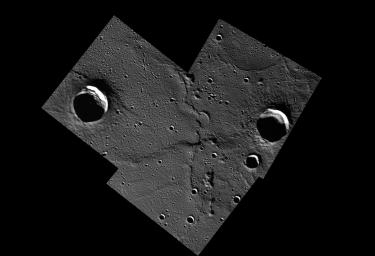This mosaic shows the geological contact between a lava flow front, which advanced from the west (left) and the pre-existing terrain that it covered. The lava flowed into and almost completely filled a medium-sized crater in the center of the scene. Other amazing lava flow features were shown in recent Gallery releases.
A portion of this mosaic appeared as Fig. 3F of J. W. Head et al. Science 333, 1853 (2011).
These images were acquired as part of MDIS's high-resolution surface morphology base map. The surface morphology base map will cover more than 90% of Mercury's surface with an average resolution of 250 meters/pixel (0.16 miles/pixel or 820 feet/pixel). Images acquired for the surface morphology base map typically have off-vertical Sun angles (i.e., high incidence angles) and visible shadows so as to reveal clearly the topographic form of geologic features.
The MESSENGER spacecraft is the first ever to orbit the planet Mercury, and the spacecraft's seven scientific instruments and radio science investigation are unraveling the history and evolution of the Solar System's innermost planet. Visit the Why Mercury? section of this website to learn more about the key science questions that the MESSENGER mission is addressing. During the one-year primary mission, MDIS is scheduled to acquire more than 75,000 images in support of MESSENGER's science goals.
Date acquired: April 20 and 22, 2011
Image ID: 153502, 163688, 163689
Instrument: Wide Angle Camera (WAC) of the Mercury Dual Imaging System (MDIS)
WAC filter: 7 (748 nanometers)
Center Latitude: 82.3°
Center Longitude: 330.9° E
Resolution: 173 meters/pixel
Scale: The two largest impact craters are about 25 km (15 mi.) in diameter.
These images are from MESSENGER, a NASA Discovery mission to conduct the first orbital study of the innermost planet, Mercury. For information regarding the use of images, see the MESSENGER image use policy.

 Planetary Data System
Planetary Data System












